Estonia
From Wikipedia, the free encyclopedia
This article is about the country. For other uses, see Estonia (disambiguation).
| Republic of Estonia Eesti Vabariik | ||||||
|---|---|---|---|---|---|---|
| ||||||
| Anthem: Mu isamaa, mu õnn ja rõõm (English: "My Fatherland, My Happiness and Joy") | ||||||
Location of Estonia (dark green) | ||||||
| Capital (and largest city) | Tallinn 59°25′N 24°45′E | |||||
| Official language(s) | Estonian1 | |||||
| Ethnic groups (2010) | 69.0% Estonians, 25.5% Russians, 2.0% Ukrainians, 1.1% Belarusians, 0.8% Finns, 1.6 % others and unspecified[1] | |||||
| Demonym | Estonian | |||||
| Government | Parliamentary republic | |||||
| - | President | Toomas Hendrik Ilves(nonpartisan, until 01 January 2007 – SDE) | ||||
| - | Prime Minister | Andrus Ansip (RE) | ||||
| - | Parliament speaker | Ene Ergma (IRL) | ||||
| - | Current coalition | (RE, IRL) | ||||
| Independence | from Russia | |||||
| - | Autonomy declared | 12 April 1917 | ||||
| - | Independence declared Officially recognised | 24 February 1918 2 February 1920 | ||||
| - | 1st Soviet occupation | 1940–1941 | ||||
| - | German occupation | 1941–1944 | ||||
| - | 2nd Soviet occupation | 1944–1991 | ||||
| - | Independence restored | 20 August 1991 | ||||
| Area | ||||||
| - | Total | 45,227 km2 (132nd2) 17,413 sq mi | ||||
| - | Water (%) | 4.45% | ||||
| Population | ||||||
| - | 2010 estimate | 1,340,194[2] (151st) | ||||
| - | 2000 census | 1,370,052[3] | ||||
| - | Density | 29/km2 (181st) 75/sq mi | ||||
| GDP (PPP) | 2011 estimate | |||||
| - | Total | $25.784 billion[4] | ||||
| - | Per capita | $19,375[4] | ||||
| GDP (nominal) | 2011 estimate | |||||
| - | Total | $20.325 billion[4] | ||||
| - | Per capita | $15,272[4] | ||||
| Gini (2009) | 31.4 | |||||
| HDI (2011) | ||||||
| Currency | Euro3 (EUR) | |||||
| Time zone | EET (UTC+2) | |||||
| - | Summer (DST) | EEST (UTC+3) | ||||
| Drives on the | right | |||||
| ISO 3166 code | EE | |||||
| Internet TLD | .ee4 | |||||
| Calling code | 372 | |||||
| 1 | Võro and Seto in southern counties are spoken along with Estonian. Russian is still unofficially spoken in Ida-Virumaa and Tallinn, due to the Soviet program promoting mass immigration of urban industrial workersfrom the USSR in the post-war period. | |||||
| 2 | 47,549 km2 (18,359 sq mi) were defined according to the Treaty of Tartu in 1920 between Estonia andRussia. Today the remaining 2,323 km2 (897 sq mi) are still occupied and part of Russia. The ceded areas include most of the former Petseri County and areas behind the Narva river includingIvangorod (Jaanilinn).[6][7] | |||||
| 3 | Before 2011: Estonian kroon (EEK; 1 EUR = 15.6466 EEK). | |||||
| 4 | .eu is also shared with other member states of the European Union. | |||||
Estonia  i/ɨsˈtoʊniə/ (Estonian: Eesti), officially the Republic of Estonia (Estonian: Eesti Vabariik), is a state in the Baltic region of Northern Europe. It is bordered to the north by the Gulf of Finland, to the west by the Baltic Sea, to the south by Latvia (343 km), and to the east by Lake Peipsi and theRussian Federation (338.6 km).[8] Across the Baltic Sea lies Sweden in the west and Finland in the north. The territory of Estonia covers 45,227 km2(17,462 sq mi), and is influenced by a temperate seasonal climate. The Estonians are a Finnic people, and the official language Estonian, is closely related to Finnish.
i/ɨsˈtoʊniə/ (Estonian: Eesti), officially the Republic of Estonia (Estonian: Eesti Vabariik), is a state in the Baltic region of Northern Europe. It is bordered to the north by the Gulf of Finland, to the west by the Baltic Sea, to the south by Latvia (343 km), and to the east by Lake Peipsi and theRussian Federation (338.6 km).[8] Across the Baltic Sea lies Sweden in the west and Finland in the north. The territory of Estonia covers 45,227 km2(17,462 sq mi), and is influenced by a temperate seasonal climate. The Estonians are a Finnic people, and the official language Estonian, is closely related to Finnish.
Estonia is a democratic parliamentary republic divided into 15 counties. The capital and largest city is Tallinn. With a population of 1.34 million, it is one of the least-populous members of the European Union, Eurozone and NATO. Estonia has the highest GDP per person among former Soviet republics.[9]Estonia is listed as a "High-Income Economy" by the World Bank, as an "advanced economy" by the International Monetary Fund and the country is anOECD member. The United Nations lists Estonia as a developed country with a Human Development Index of "Very High".[5] The country is also ranked highly for press freedom, economic freedom, democracy and political freedom and education.
Contents[hide] |
[edit]Etymology
One theory is that the modern name of Estonia originated from the Aesti described by the Roman historian Tacitus in his Germania (ca. 98 AD).[10]
On the other hand, ancient Scandinavian sagas refer to a land called Eistland, close to the Danish, German, Dutch, Swedish and Norwegian term Estlandfor the country. Early Latin and other ancient versions of the name are Estia and Hestia.[citation needed]
[edit]History
Main article: History of Estonia
[edit]Prehistory
Main article: Ancient Estonia
Human settlement in Estonia became possible 11,000 to 13,000 years ago, when the ice from the last glacial era melted. The oldest known settlement in Estonia is the Pulli settlement, which was on the banks of the river Pärnu, near the town of Sindi, in south-western Estonia. According to radiocarbon dating it was settled around 11,000 years ago at the beginning of the 9th millennium BC.
Evidence has been found of hunting and fishing communities existing around 6500 BC near the town of Kundain northern Estonia. Bone and stone artefacts similar to those found at Kunda have been discovered elsewhere in Estonia, as well as in Latvia, northern Lithuania and in southern Finland. The Kunda culture belongs to the middle stone age, or Mesolithic period.
The end of the Bronze Age and the early Iron Age were marked by great cultural changes. The most significant was the transition to farming, which has remained at the core of the economy and culture. Between the 1st to 5th centuries AD resident farming was widely established, the population grew, and settlement expanded. Cultural influences from the Roman Empire reached Estonia.
The first mention of the people inhabiting present-day Estonia is by the Roman historian Tacitus, who in his book Germania (ca. AD 98) describes the Aesti tribe. Tacitus mentions their term for amber in an apparently Latinised form, glesum (cf. Latvian glīsas). This is the only word of their language recorded from antiquity. In spite of this point, the Aestii are generally considered the ancestors of the later Baltic peoples.[14][15][16]
A more troubled and war-ridden middle Iron Age followed with external dangers coming both from the Baltic tribes, who attacked across the southern land border, and from overseas. Several Scandinavian sagas refer to retaliatory campaigns against Estonia. Estonian pirates conducted similar raids against theVikings. The "pagan raiders" who sacked the Swedish town of Sigtuna during the early Middle Ages, in 1187, were Estonians.[17]
In the 1st centuries AD, political and administrative subdivisions began to emerge in Estonia. Two larger subdivisions appeared: the province (Estonian:kihelkond) and the land (Estonian: maakond). The province comprised several elderships or villages. Nearly all provinces had at least one fortress. The defense of the local area was directed by the highest official, the king or elder. By the 13th century the following major lands had developed in Estonia:Revala, Harjumaa, Saaremaa, Hiiumaa, Läänemaa, Alempois, Sakala, Ugandi, Jogentagana, Soopoolitse, Vaiga, Mõhu, Nurmekund, Järvamaa andVirumaa.[18]
Estonia retained a pagan religion centred around a deity called Tharapita. The Chronicle of Henry of Livonia mentions Tharapita as the superior god ofOeselians (inhabitants of Saaremaa island), also well known to Vironian tribes in northern Estonia.
[edit]Middle Ages
At the beginning of the 13th century, Lembitu of Lehola, a chieftain of Sakala sought to unify the Estonian people and thwart Danish and Germanic conquest during the Livonian Crusade. He managed to assemble an army of 6,000 Estonian men from different counties, but he was killed during the Battle of St. Matthew's Day in September 1217.[19]
In 1228, in the aftermath of the Livonian Crusade, to the 1560s, Estonia became part of Terra Mariana, established on 2 February 1207[20] as a principality of the Holy Roman Empire[21] and proclaimed by pope Innocent III in 1215 as a subject to the Holy See.[22] The southern parts of the country were conquered by Livonian Brothers of the Sword who joined the Teutonic Order in 1237 and became its branch known as Livonian Order. The Duchy of Estonia was formed in the northern parts of the country[23] as a direct dominion of the King of Denmark from 1219 until 1346 when it was sold to the Teutonic order and became part of the Ordenstaat.[24] In 1343, the people of northern Estonia and Saaremaa rebelled against the German rule in the St. George's Night Uprising, which was put down by 1345.
Reval (known as Tallinn since 1918) gained Lübeck Rights in 1248 and joined an alliance of trading guilds called the Hanseatic League at the end of the 13th century.
After the Teutonic Order fell into decline following its defeat in the Battle of Grunwald in 1410, and the defeat of the Livonian Order in the Battle of Swienta on 1 September 1435, the Livonian Confederation agreement was signed on 4 December 1435.[25] The Grand Duchy of Moscow andTsardom of Russia attempted unsuccessful invasions in 1481 and 1558.
The Livonian Confederation ceased to exist during the Livonian War (1558–82). The wars had reduced the Estonian population from about 250–300,000 people before the Livonian War to 120–140,000 in the 1620s.[26]
[edit]Reformation and Swedish Estonia
The Reformation in Europe officially began in 1517 with Martin Luther (1483–1546) and his 95 Theses. The Reformation resulted in great change in the Baltic region. Ideas entered the Livonian Confederation very quickly and by the 1520s they were well known. Language, education, religion, and politics were greatly transformed. The Church services were now given in the local vernacular, instead of Latin, as was previously used.[27] During the Livonian War in 1561, northern Estonia submitted to Swedish control. Southern Estonia in 1560s formed an autonomous Duchy of Livonia in the Polish-Lithuanian Commonwealthunder joint control of the Polish Crown and the Grand Duchy, containing two voivodeships of present-day Estonia: Dorpat Voivodeship (Tartu region) andParnawa Voivodeship (Pärnu region). In 1629, mainland Estonia came entirely under Swedish rule. Estonia was administratively divided between the provinces of Estonia in the north and Livonia in southern Estonia and northern Latvia, a division which persisted until the early 20th century.
In 1631, the Swedish king Gustaf II Adolf forced the nobility to grant the peasantry greater rights, although serfdom was retained. King Charles XI withdrew large noble estates to the Swedish Crown effectively turning serfs to taxpaying farmers. In 1632, a printing press and university were established in the city ofDorpat (known as Tartu since 1918). This period is known in Estonian history as "the Good Old Swedish Time."
The steady growth of the population continued until the outbreak of the plague in 1657. The Great Famine of 1695–97 killed some 70,000 people – almost 20% of the population.[26]
[edit]Russian Empire
Main articles: Governorate of Estonia and Autonomous Governorate of Estonia
Following the Capitulation of Estonia and Livonia during the Great Northern War, the Swedish empire lost Estonia to Russia by the Treaty of Nystad. However, the upper classes and the higher middle class remained primarily Baltic German. The war devastated the population of Estonia, but it recovered quickly. Although the rights of peasants were initially weakened, serfdom was abolished in 1816 in the province of Estonia and in 1819 in Livonia. After the Russian revolution of 1917, Tallinn remained under Soviet control until 24 February 1918, when Estonian independence was declared.
[edit]Declaration of independence
Main articles: Occupation of Estonia by the German Empire, United Baltic Duchy, Estonian War of Independence, and Vaps Movement
As a result of the abolition of serfdom and the availability of education to the native Estonian-speaking population, an active Estonian nationalist movement developed in the 19th century. It began on a cultural level, resulting in the establishment of Estonian language literature, theatre and professional music and led on to the formation of the Estonian national identity and the Age of Awakening. Among the leaders of the movement were Johann Voldemar Jannsen,Jakob Hurt and Carl Robert Jakobson.
Significant accomplishments were the publication of the national epic, Kalevipoeg, in 1862, and the organization of the first national song festival in 1869. In response to a period of Russification initiated by the Russian empire in the 1890s, Estonian nationalism took on more political tones, with intellectuals first calling for greater autonomy, and later, complete independence from the Russian Empire.
Following the Bolshevik takeover of power in Russia after the October Revolution of 1917 and German victories against the Russian army, between the Russian Red Army's retreat and the arrival of advancing German troops, the Committee of Elders of the Maapäev issued the Estonian Declaration of Independence[28] in Pärnu on 23 February and in Tallinn on 24 February 1918.
After winning the Estonian War of Independence against both Soviet Russia and the German Freikorps and Baltische Landeswehr volunteers, (the Tartu Peace Treaty was signed on 2 February 1920). The Republic of Estonia was recognised (de jure) by Finland on 7 July 1920, Poland on 31 December 1920, Argentina on 12 January 1921 and by the Western Allies on 26 January 1921.
Estonia maintained its independence for twenty-two years. Initially a parliamentary democracy, the parliament (Riigikogu) was disbanded in 1934, following political unrest caused by the global economic crisis. Subsequently the country was ruled by decree by Konstantin Päts, who became President in 1938, the year parliamentary elections resumed.
[edit]World War II
Main article: Estonia in World War II
The fate of Estonia in World War II was decided by the German–Soviet Nonaggression Pact and its Secret Additional Protocol of August 1939. World War II casualtiesof Estonia, estimated at around 25% of the population, were among the highest in Europe. War and occupation deaths have been estimated at 90,000. These include the Soviet deportations in 1941, the German deportations and Holocaust victims.[29] World War II began with the invasion and subsequent partition of an important regional ally of Estonia – Poland, by a joint operation of Nazi Germanyand Soviet Union.
[edit]Soviet invasion and occupation
Main article: Occupation of the Baltic states
The fate of the Republic of Estonia before World War II was decided by the German–Soviet Nonaggression Pact of August 1939 afterJoseph Stalin gained Adolf Hitler's agreement to divide Eastern Europe into "spheres of special interest" according to the Molotov–Ribbentrop Pact and its Secret Additional Protocol.[30][31]
On 24 September 1939, warships of the Red Navy appeared off Estonian ports and Soviet bombers began a patrol over Tallinn and the nearby countryside.[32] The Estonian government was forced to give their assent to an agreement which allowed the USSR to establish military bases and station 25,000 troops on Estonian soil for "mutual defence".[33] On 12 June 1940, the order for a total military blockade on Estonia was given to the Soviet Baltic Fleet.[34]
On 14 June 1940, while world's attention was focused on the fall of Paris to Nazi Germany a day earlier, the Soviet military blockade on Estonia went into effect, two Soviet bombers downed the Finnish passenger airplane "Kaleva" flying from Tallinn to Helsinki carrying three diplomatic pouches from the U.S. legations in Tallinn, Riga and Helsinki.[35] On 16 June 1940, the Soviet Union invaded Estonia.[36] The Red Army exited from their military bases in Estonia on 17 June.[37] The following day, some 90,000 additional troops entered the country. In the face of overwhelming Soviet force, the Estonian government capitulated on 17 June 1940 to avoid bloodshed.[38]
The military occupation of Estonia was complete by the 21 June 1940.[39]
Most of the Estonian Defence Forces surrendered according to the orders of the Estonian Government believing that resistance was useless and were disarmed by the Red Army.[40][41] Only the Estonian Independent Signal Battalion stationed in Tallinn at Raua Street showed resistance to Red Army and Communist Militia called "People's Self-Defence"[42] on 21 June 1940.[43] As the Red Army brought in additional reinforcements supported by six armoured fighting vehicles, the battle lasted several hours until sundown. Finally the military resistance was ended with negotiations and the Independent Signal Battalion surrendered and was disarmed.[44] There were 2 dead Estonian servicemen, Aleksei Männikus and Johannes Mandre, and several wounded on the Estonian side and about 10 killed and more wounded on the Soviet side.[45][46] The Soviet militia that participated in the battle was led by Nikolai Stepulov.[47]
In August 6, 1940, Estonia was illegally annexed by the Soviet Union as the Estonian SSR.[48] The provisions in the Estonian constitution requiring a popular referendum to decide on joining a supra-national body were ignored. Instead the vote to join the Soviet Union was taken by those elected in the sham elections held in the previous month. Additionally those who had failed to do their "political duty" of voting Estonia into the USSR, specifically those who had failed to have their passports stamped for voting, were condemned to death by Soviet tribunals.[49] The repressions followed with the mass deportations carried out by the Soviets in Estonia on 14 June 1941. Many of the country's political and intellectual leaders were killed or deported to remote areas of the USSR by the Soviet authorities in 1940–1941. Repressive actions were also taken against thousands of ordinary people.
When the German Operation Barbarossa started against the Soviet Union, about 34,000 young Estonian men were forcibly drafted into the Red Army. Fewer than 30% of them survived the war. Political prisoners who could not be evacuated were executed by the NKVD.[50]
Many countries, including the US, did not recognise the annexation of Estonia by the USSR. Such countries recognised Estonian diplomats and consuls who still functioned in many countries in the name of their former governments. These diplomats persisted in this anomalous situation until the ultimate restoration of Baltic independence.[51]
Contemporary Russian politicians deny that the Republic of Estonia was illegally annexed by the Soviet Union in 1940. They state that the Soviet troops had entered Estonia in 1940 following the agreements and with the consent of the government of the Republic of Estonia, regardless of how their actions can be interpreted today. They maintain that the USSR was not in a state of war and was not waging any combat activities on the territory of Estonia; therefore there could be no occupation. The official Soviet and current Russian version claims that Estonians voluntarily gave up their statehood. Freedom fighters of 1944–1976 are labeled "bandits" or "nazis". The Russian position is not recognised internationally.[52]
[edit]German occupation
Main articles: Occupation of Estonia by Nazi Germany, Germanisation, The Holocaust, Reichskommissariat Ostland, and Generalplan Ost
After Germany invaded the Soviet Union on 22 June 1941, the Wehrmacht was able to reach Estonia within days. The German Army crossed the Estonian southernborder on 7 July. The Red Army retreated behind the Pärnu River – Emajõgi line on 12 July. At the end of July the Germans resumed their advance in Estonia working in tandem with the Estonian Forest Brothers. Both German troops and Estonian partisans took Narva on 17 August and the Estonian capital Tallinn on 28 August. After the Soviets were driven out from Estonia German troops disarmed all the partisan groups.[53]
Although initially the Germans were perceived by most Estonians as liberators from the USSR and its repressions, and hopes were raised for the restoration of the country's independence, it was soon realised that they were but another occupying power. The Germans used Estonia's resources for the war effort; for the duration of the occupation Estonia and was incorporated into the German province of Ostland.
This led many Estonians, unwilling to side with the Nazis, to join the Finnish Army to fight against the Soviet Union. The Finnish Infantry Regiment 200 (Estonian:soomepoisid) was formed out of Estonian volunteers in Finland. Although many Estonians were recruited into the German armed forces (including Estonian Waffen-SS), the majority did so only in 1944 when the threat of a new invasion of Estonia by the Red Army had become imminent and it was clear that Nazi Germany could not win the war.[54]
By January 1944, the front was pushed back by the Red Army almost all the way to the former Estonian border. Narva was evacuated. Jüri Uluots, the last legitimate prime minister of the Republic of Estonia (according to the Constitution of the Republic of Estonia) prior to its fall to the Soviet Union in 1940, delivered a radio address that appealed to all able-bodied men born from 1904 through 1923 to report for military service (Before this, Jüri Uluots had opposed Estonian mobilization.) The call drew support from all across the country: 38,000 volunteers jammed registration centres.[55]
Several thousand Estonians who had joined the Finnish Army came back across the Gulf of Finland to join the newly formed Territorial Defense Force, assigned to defend Estonia against the Soviet advance. It was hoped that by engaging in such a war Estonia would be able to attract Western support for the cause of Estonia's independence from the USSR and thus ultimately succeed in achieving independence.[56]
[edit]Soviet Estonia
Main articles: Estonian Soviet Socialist Republic, Occupation of the Baltic states, and Estonian Government in Exile
The Soviet forces reconquered Estonia in the autumn of 1944 after fierce battles in the northeast of the country on the Narva river, on the Tannenberg Line (Sinimäed), in Southeast Estonia, on theEmajõgi river, and in the West Estonian Archipelago.
In the face of the country being re-occupied by the Red Army, tens of thousands of Estonians (including a majority of the education, culture, science, political and social specialists) (estimates as many as 80,000) chose to either retreat with the Germans or flee to Finland or Sweden. On 12 January 1949, the Soviet Council of Ministers issued a decree "on the expulsion and deportation" fromBaltic states of "all kulaks and their families, the families of bandits and nationalists", and others.[57]
More than 200,000 people are estimated to have been deported from the Baltic in 1940–1953. In addition, at least 75,000 were sent to Gulag. More than 10% of the entire adult Baltic population was deported or sent to Soviet labor camps.[57] In response to the continuing insurgency against Soviet rule,[58] more than 20,000 Estonians were forcibly deported either to labor camps or Siberia (seeGulag).[59] Within the few weeks that followed, almost all of the remaining rural households were collectivized.
After World War II, as part of the goal to more fully integrate Baltic countries into the Soviet Union, mass deportations were concluded in the Baltic countries and the policy of encouraging Soviet immigration to the Baltic states continued.[60] In addition to the human and material losses suffered due to war, thousands of civilians were killed and tens of thousands of people deported from Estonia by the Soviet authorities until Joseph Stalin's death in 1953.
Half of the deported perished, the other half were not allowed to return until the early 1960s (years after Stalin's death).[citation needed] The various repressive activities of Soviet forces in 1940–1941 and after reoccupation sparked a guerrilla war against the Soviet authorities in Estonia which was waged into the early 1950s by "forest brothers" (metsavennad) consisting mostly of Estonian veterans of both the German and Finnish armies as well as some civilians.[61] Material damage caused by the world war and the following Soviet era significantly slowed Estonia's economic growth, resulting in a wide wealth gap in comparison with neighboring Finland and Sweden.[62]
Militarization was another aspect of the Soviet regime. Large parts of the country, especially the coastal areas were closed to all but the Soviet military. Most of the sea shore and all sea islands (including Saaremaa and Hiiumaa) were declared "border zones". People not actually resident there were restricted from traveling to them without a permit. A notable closed military installation was the city of Paldiski which was entirely closed to all public access. The city had a support base for the Soviet Baltic Fleet's submarines and several large military bases, including a nuclear submarine training centre complete with a full-scale model of a nuclear submarine with working nuclear reactors. The Paldiski reactors building passed into Estonian control in 1994 after the last Soviet troops left the country.[63][64] Immigration was another effect of Soviet occupation. Hundreds of thousands of migrants were relocated to Estonia from other parts of Soviet Union to assist industrialization and militarization, contributing an increase of about half a million people within 45 years.[65]
[edit]Post-independence
Main articles: Singing Revolution and Baltic Way
The US, UK, France, Italy and the majority of other Western democracies considered the annexation of Estonia by the USSR illegal. They retained diplomatic relations with the representatives of the independent Republic of Estonia, never de jure recognised the existence of the Estonian SSR, and never recognised Estonia as a legal constituent part of the Soviet Union.[66] Estonia's return to independence became possible as the Soviet Union faced internal regime challenges, loosening its hold on the outer empire. As the 1980s progressed, a movement for Estonian autonomy started. In the initial period of 1987–1989, this was partially for more economic independence, but as the Soviet Union weakened and it became increasingly obvious that nothing short of full independence would do, the country began a course towards self-determination.
In 1989, during the "Singing Revolution", in a landmark demonstration for more independence, called the Baltic Way, a human chain of more than two million people was formed, stretching through Lithuania, Latvia and Estonia. All three nations had similar experiences of occupation and similar aspirations for regaining independence. The Estonian Sovereignty Declaration was issued on 16 November 1988[67] and formal independence declared on 20 August 1991, reconstituting the pre-1940 state, during the Soviet military coup attempt in Moscow. The Soviet Union recognised the independence of Estonia on 6 September 1991. The first country to diplomatically recognize Estonia's reclaimed independence was Iceland. The last Russian troops left on 31 August 1994.
The 2004 enlargement of the European Union was the largest single expansion of the European Union (EU), both in terms of territory and population, however not in terms of gross domestic product (wealth). Estonia was amongst a group of ten countries which were incorporated into the EU on 1 May 2004. TheTreaty of Accession 2003 was signed on 16 April 2003.
[edit]Territorial history timeline
 |
[edit]Geography
Main articles: Geography of Estonia, Protected areas of Estonia, Climate of Estonia, and Fauna of Estonia
Estonia's land border with Latvia runs 267 kilometers; the Russian border runs 290 kilometers. From 1920 to 1945, Estonia's border with Russia, set by the 1920 Tartu Peace Treaty, extended beyond the Narva River in the northeast and beyond the town of Pechory (Petseri) in the southeast. This territory, amounting to some 2,300 square kilometers (888 sq mi), was incorporated into Russia by Stalin at the end of World War II. For this reason the borders between Estonia and Russia are not still defined today.
Estonia lies on the eastern shores of the Baltic Sea immediately across the Gulf of Finland from Finland on the level northwestern part of the rising east European platform between 57.3° and 59.5° N and 21.5° and 28.1° E. Average elevation reaches only 50 meters (164 ft) and the country's highest point is theSuur Munamägi in the southeast at 318 meters (1,043 ft). There is 3,794 kilometers (2,357 mi) of coastline marked by numerous bays, straits, and inlets. The number of islands and islets is estimated at some 1,500. Two of them are large enough to constitute separate counties: Saaremaa and Hiiumaa.[68][69] A small, recent cluster of meteorite craters, the largest of which is called Kaali is found on Saaremaa, Estonia.
Estonia is situated in the northern part of the temperate climate zone and in the transition zone between maritime and continental climate. Estonia has four seasons of near-equal length. Average temperatures range from 16.3 °C (61.3 °F) on the Baltic islands to 18.1 °C (64.6 °F) inland in July, the warmest month, and from −3.5 °C (25.7 °F) on the Baltic islands to −7.6 °C (18.3 °F) inland in February, the coldest month. The average annual temperature in Estonia is5.2 °C (41.4 °F).[70] The average precipitation in 1961–1990 ranged from 535 to 727 mm (21.1 to 28.6 in) per year.[71]
Snow cover, which is deepest in the south-eastern part of Estonia, usually lasts from mid-December to late March. Estonia has over 1,400 lakes. Most are very small, with the largest, Lake Peipus, (Peipsi in Estonian) being 3,555 km2 (1,373 sq mi). There are many rivers in the country. The longest of them are Võhandu (162 km/101 mi), Pärnu (144 km/89 mi), and Põltsamaa (135 km/84 mi).[68] Estonia has numerous fens and bogs.
Phytogeographically, Estonia is shared between the Central European and Eastern European provinces of the Circumboreal Region within the Boreal Kingdom. According to the WWF, the territory of Estonia belongs to the ecoregion of Sarmatic mixed forests.
[edit]Administrative divisions
Main articles: Counties of Estonia, Municipalities of Estonia, Boroughs of Estonia, Small boroughs of Estonia, and Populated places in Estonia
The Republic of Estonia is divided into fifteen counties (Maakonnad) which are the administrative subdivisions of the country. The first documented mentioning of Estonian political and administrative subdivisions comes from the Chronicle of Henry of Livonia, written in the 13th century during the Northern Crusades.[72]
A maakond (county) is the biggest administrative subdivision. The county government(Maavalitsus) of each county is led by a county governor (Maavanem), who represents the national government at the regional level. Governors are appointed by the Government of Estoniafor a term of five years. Several changes were made to the borders of counties after Estonia became independent, most notably the formation of Valga County (from parts of Võru, Tartu andViljandi counties) and Petseri County (area acquired from Russia with the 1920 Tartu Peace Treaty).
During the Soviet rule, Petseri County was annexed and ceded to the Russian SFSR in 1945 where it became one the Pskovs districts. Counties were again re-established on 1 January 1990 in the borders of the Soviet-era regions. Because of the numerous differences between the current and historical (pre-1940, and sometimes pre-1918) layouts, the historical borders are still used in ethnology, representing cultural and linguistic differences better.
Estonia is divided into 15 counties (maakond). Each county is further divided into municipalities (omavalitsus), which is also the smallest administrative subdivision of Estonia. There are two types of municipalities: an urban municipality – linn (town), and a rural municipality – vald (parish). There is no other status distinction between them. Each municipality is a unit of self-government with its representative and executive bodies. The municipalities in Estonia cover the entire territory of the country.
A municipality may contain one or more populated places. Tallinn is divided into eight districts (linnaosa) with limited self-government (Haabersti, Kesklinn(centre), Kristiine, Lasnamäe, Mustamäe, Nõmme, Pirita and Põhja-Tallinn).
Municipalities range in size from Tallinn with 400,000 inhabitants to Ruhnu with as few as 60. As over two-thirds of the municipalities have a population of under 3,000, many of them have found it advantageous to co-operate in providing services and carrying out administrative functions. There have also been calls for an administrative reform to merge smaller municipalities together.
As of March 2008, there are a total of 227 municipalities in Estonia, 33 of them being urban and 193 rural.
[edit]Politics
Politics of Estonia takes place in a framework of a parliamentary representative democratic republic in which thePrime Minister of Estonia is the head of government and of a multi-party system. The political culture is very stable in Estonia, where the power is held between two to three parties, that have been in politics for a long time. This situation is similar to other countries in Northern Europe. The current prime minister of Estonia, Andrus Ansip, is the second longest-serving prime minister in Europe.
[edit]Parliament
Main article: Riigikogu
The Parliament of Estonia (Estonian: Riigikogu) or the legislative branch is elected by people for a four year term by proportional representation. Estonia is aparliamentary representative democratic republic. The Estonian political system operates under a framework laid out in the 1992 constitutional document. The Estonian parliament has 101 members and influences the governing of the state primarily by determining the income and the expenses of the state (establishing taxes and adopting the budget). At the same time the parliament has the right to present statements, declarations and appeals to the people of Estonia, ratify and denounce international treaties with other states and international organisations and decide on the Government loans.[73]
The Riigikogu elects and appoints several high officials of the state, including the President of the Republic. In addition to that, the Riigikogu appoints, on the proposal of the President of Estonia, the Chairman of the National Court, the Chairman of the Board of the Bank of Estonia, the Auditor General, the Legal Chancellor and the Commander-in-Chief of the Defence Forces. A member of the Riigikogu has the right to demand explanations from the Government of the Republic and its members. This enables the members of the parliament to observe the activities of the executive power and the above mentioned high officials of the state.
[edit]Government
The Government of Estonia (Estonian: Vabariigi Valitsus) or the executive branch is formed by the Prime Minister of Estonia, nominated by the president and approved by the parliament. The government exercises executive power pursuant to the Constitution of Estonia and the laws of the Republic of Estonia and consists of 12 ministers, including the prime minister. The prime minister also has the right to appoint other ministers, whom he or she will assign with a subject to deal with and who will not have a ministry to control, becoming a minister without portfolio who currently is the Minister of Regions.
The prime minister has the right to appoint a maximum of 3 such ministers, as the limit of ministers in one government is 15. It is also known as the cabinet. The cabinet carries out the country's domestic and foreign policy, shaped by parliament; it directs and co-ordinates the work of government institutions and bears full responsibility for everything occurring within the authority of executive power. The government, headed by the Prime Minister, thus represents the political leadership of the country and makes decisions in the name of the whole executive power.
Estonia has pursued the development of the e-state and e-government. Internet voting is used in elections in Estonia.[74] The first Internet voting took place in the 2005 local elections and the first in a parliamentary election was made available for the 2007 elections, in which 30,275 individuals voted over the Internet. Voters have a chance to invalidate their electronic vote in traditional elections, if they wish to. In 2009 in its 8th Worldwide Press Freedom Index, Reporters Without Borders ranked Estonia 6th out of 175 countries.[75] In the first ever State of World Liberty Index report, Estonia was ranked 1st out of 159 countries.
[edit]Law
Main article: Law of Estonia
See also: Police and Border Guard Board
According to the Constitution of Estonia (Estonian: Põhiseadus) the supreme power of the state is vested in the people. The people exercise their supreme power of the state on the elections of the Riigikogu through citizens who have the right to vote.[76] The supreme judicial power is vested in the Supreme Courtor Riigikohus, with 19 justices.[77] The Chief Justice is appointed by the parliament for nine years on nomination by the president. The official Head of State is the President of Estonia, who gives assent to the laws passed by Riigikogu, also having the right of sending them back and proposing new laws.
The president, however, does not use these rights very often, having a largely ceremonial role. He or she is elected by Riigikogu, with two-thirds of the votes required. If the candidate does not gain the amount of votes required, the right to elect the president goes over to an electoral body, consisting of the 101 members of Riigikogu and representatives from local councils. As other spheres, Estonian law-making has been successfully integrated with the Information Age.
[edit]Foreign relations
Main articles: Foreign relations of Estonia, Diplomatic missions of Estonia, Estonia–Russia relations, and Estonia – United States relations
Estonia was a member of the League of Nations from 22 September 1921,[78] has been a member of the United Nations since 17 September 1991,[79] and ofNATO since 29 March 2004,[80] as well as the European Union since 1 May 2004.[81] Estonia has also signed the Kyoto protocol. Estonia is a member of theOrganization for Security and Cooperation in Europe (OSCE). As an OSCE participating State, Estonia’s international commitments are subject to monitoring under the mandate of the U.S. Helsinki Commission.
Since regaining independence, Estonia has pursued a foreign policy of close cooperation with its Western European partners. The two most important policy objectives in this regard have been accession into NATO and the European Union, achieved in March and May 2004 respectively. Estonia's international realignment toward the West has been accompanied by a general deterioration in relations with Russia, most recently demonstrated by the controversy surrounding the relocation of the Bronze Soldier WWII memorial in Tallinn.[82]
An important element in Estonia's post-independence reorientation has been closer ties with the Nordic countries, especially Finland and Sweden. Indeed, Estonians consider themselves a Nordic people rather than Balts,[83][84]based on their historical ties with Sweden, Denmark and particularly Finland. In December 1999, then Estonian foreign minister (and since 2006, president of Estonia) Toomas Hendrik Ilves delivered a speech entitled "Estonia as a Nordic Country" to the Swedish Institute for International Affairs.[85] In 2003, the foreign ministry also hosted an exhibit called "Estonia: Nordic with a Twist".[86]
In 2005, Estonia joined the European Union's Nordic Battle Group. It has also shown continued interest in joining the Nordic Council. Whereas in 1992 Russia accounted for 92% of Estonia's international trade,[87] today there is extensive economic interdependence between Estonia and its Nordic neighbors: three quarters of foreign investment in Estonia originates in the Nordic countries (principally Finland and Sweden), to which Estonia sends 42% of its exports (as compared to 6.5% going to Russia, 8.8% to Latvia, and 4.7% to Lithuania). On the other hand, the Estonian political system, its flat rate of income tax, and its non-welfare-state model distinguish it from the other Nordic states, and indeed from many other European countries.[88]
[edit]Military
Main article: Military of Estonia
The military of Estonia is based upon the Estonian Defence Forces (Estonian: Kaitsevägi) which is the name of the unified armed forces of the republic with Maavägi (Army), Merevägi (Navy), Õhuvägi (Air Force) and a paramilitary national guard organization Kaitseliit (Defence League). The Estonian National Defence Policy aim is to guarantee the preservation of the independence and sovereignty of the state, the integrity of its land, territorial waters, airspace and its constitutional order.[89] At the moment the main strategic goals are to be able to defend the country's interests and development of the armed forces which would be ready to be interoperability with the other armed forces of NATO and European Union member states and also their capability to participate in NATO missions.
The current national military service (Estonian: ajateenistus) is compulsory for men between 18 and 28, and conscripts serve eight-month to eleven-month tours of duty depending on the army branch they serve in. Estonia has retained conscription unlike Latvia and Lithuania and has no plan to transition to a professional army. In 2008, annual military spending will reach 1.85% of GDP, or 5 billion kroons, and will continue to increase until 2010, when a 2.0% level is expected to be reached.[90]
As of January 2008, the Estonian military had almost 300 troops stationed in foreign countries as part of various international peacekeeping forces, including 35 Defence League troops stationed in Kosovo; 120 Ground Forcessoldiers in the NATO-led ISAF force in Afghanistan; 80 soldiers stationed as a part of MNF in Iraq; and 2 Estonian officers in Bosnia-Herzegovina and 2 Estonian military agents in Israel's Golan Heights.[91]
The Estonian Defence Forces have also previously had military missions in Croatia from March until October 1995, in Lebanon from December 1996 until June 1997 and in Macedonia from May until December 2003.[92] Estonia participates in the Nordic Battlegroup and has announced readiness to send soldiers also to Sudan to Darfur if necessary, creating the very first African peacekeeping mission for the armed forces of Estonia.[93]
The Ministry of Defence and the Defence Forces have been working on a cyberwarfare and defence formation for some years now. In 2007, a military doctrineof an e-military of Estonia was officially introduced as the country was under massive cyberattacks in 2007.[94] The proposed aim of the e-military is to secure the vital infrastructure and e-infrastructure of Estonia. The main cyber warfare facility is the Computer Emergency Response Team of Estonia (CERT) which was founded in 2006. The organization operates with the security problems that occur in the local networks also with those which are started there.[95]
On 25 June 2007, Estonian president Toomas Hendrik Ilves met with the President of the US, George W. Bush.[96] Among the topics discussed were the attacks on Estonian e-infrastructure.[97] The attacks triggered a number of military organisations around the world to reconsider the importance of network security to modern military doctrine. On 14 June 2007, defence ministers of NATOmembers held a meeting in Brussels, issuing a joint communiqué promising immediate action. First public results were estimated to arrive by autumn 2007.[98]
As to the placement of a NATO Cooperative Cyber Defence Centre of Excellence (CCDCOE), Bush announced his support of Estonia as this centre's location.[99] In the aftermath of the 2007 cyberattacks, plans to combine network defence with Estonian military doctrine have been nicknamed as the Tiger's Defence, in reference to Tiigrihüpe.[100] The CCDCOE started its operations in November 2008.[101]
[edit]Economy
Main article: Economy of Estonia
As a member of the European Union, Estonia's economy is rated as high income by the World Bank. Because of its rapid growth, the Estonian economy has often been described as the Baltic Tiger. Beginning 1 January 2011, Estonia adopted the euro and became the 17th eurozone member state.[102]
According to Eurostat newsrelease published at 21 October 2011, Estonia has the lowest ratio of government debt to GDP among EU countries as 6.7 percent at the end of 2010. The world media has lately started to describe Estonia as a Nordic country, emphasizing the economic, political and cultural differences between Estonia and its less successful Baltic neighbors.[103]
A balanced budget, almost non-existent public debt, flat-rate income tax, free trade regime, c


![Location of Estonia (dark green)– in Europe (green & dark grey)– in the European Union (green) — [Legend]](http://upload.wikimedia.org/wikipedia/commons/thumb/a/a2/EU-Estonia.svg/250px-EU-Estonia.svg.png)


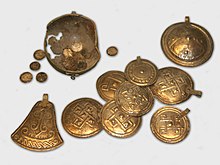
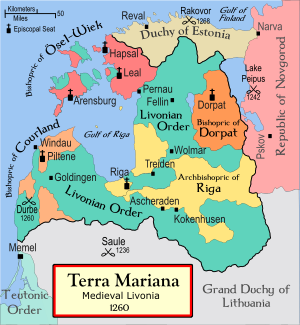



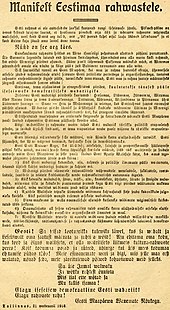


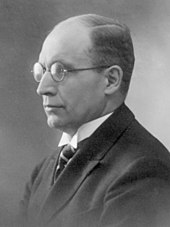
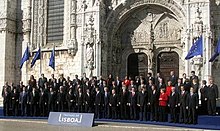

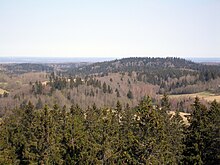




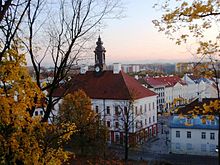



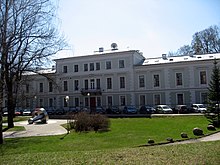







No comments:
Post a Comment